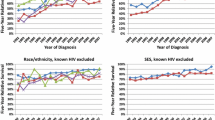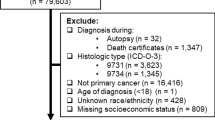Abstract
Survival after Hodgkin lymphoma (HL) is generally favorable, but may vary by patient demographic characteristics. The authors examined HL survival according to race/ethnicity and neighborhood socioeconomic status (SES), determined from residential census-block group at diagnosis. For 12,492 classical HL patients ≥15 years diagnosed in California during 1988–2006 and followed through 2007, we determined risk of overall and HL-specific death using Cox proportional hazards regression; analyses were stratified by age and Ann Arbor stage. Irrespective of disease stage, patients with lower neighborhood SES had worse overall and HL-specific survival than patients with higher SES. Patients with the lowest quintile of neighborhood SES had a 64% (patients aged 15–44 years) and 36% (≥45 years) increased risk of HL-death compared to patients with the highest quintile of SES; SES results were similar for overall survival. Even after adjustment for neighborhood SES, blacks and Hispanics had increased risks of HL-death 74% and 43% (15–44 years) and 40% and 17% (≥45 years), respectively, higher than white patients. The racial/ethnic differences in survival were evident for all stages of disease. These data provide evidence for substantial, and probably remediable, racial/ethnic and neighborhood SES disparities in HL outcomes.

Similar content being viewed by others
References
Ries LAG, Melbert D, Krapcho M, Mariotto A, Miller BA, Feuer EJ et al. (2007) SEER cancer statistics review, 1975–2004. http://seer.cancer.gov/csr/1975_2004/. Accessed July 2008 SEER data submission, posted to the SEER web site, 2007
Ng AK, Mauch PM (2004) Late complications of therapy of Hodgkin’s disease: prevention and management. Curr Hematol Rep 3(1):27–33
Hoppe RT (2005) The John Ultmann lecture—the role of radiation therapy in the treatment of Hodgkin’s disease: past, present, and future. Eur J Haematol 66:14–20
Klimm B, Diehl V, Pfistner B, Engert A (2005) Current treatment strategies of the German Hodgkin Study Group (GHSG). Eur J Haematol 66:125–134
Elston L, Cole J, Ben Manachem T, Morlock R (2001) Sociodemographic differences in the receipt of colorectal cancer surveillance care following treatment with curative intent. Med Care 39:361–372
VanEenwyk J, Campo J, Ossiander E (2002) Socioeconomic and demographic disparities in treatment for carcinomas of the colon and rectum. Cancer 95:39–46
Yabroff K, Gordis L (2003) Does stage at diagnosis influence the observed relationship between socioeconomic status and breast cancer incidence, case-fatality, and mortality? Soc Sci Med 57:2265–2279
Cella DF, Orav EJ, Kornblith AB, Holland JC, Silberfarb PM, Lee KW et al (1991) Socioeconomic status and cancer survival. J Clin Oncol 9(8):1500–1509
Boyd C, Zhang-Salomons JY, Groome PA, Mackillop WJ (1999) Associations between community income and cancer survival in Ontario, Canada, and the United States. J Clin Oncol 17(7):2244–2255
Soares A, Biasoli I, Scheliga A, Luiz RR, Costa MA, Land M et al (2007) Socioeconomic inequality and short-term outcome in Hodgkin’s lymphoma. Int J Cancer 120(4):875–879
Clarke CA, Glaser SL, Prehn AW (2001) Age-specific survival after Hodgkin’s disease in a population-based cohort (United States). Cancer Causes Control 12(9):803–812
Zaki A, Natarajan N, Mettlin CJ (1993) Early and late survival in Hodgkin disease among whites and blacks living in the United States. Cancer 72(2):602–606
Holzner B, Fischhofer M, Kemmler G, Kopp M, Sperner-Unterweger B, Krugmann J et al (2004) Is higher income and educational status associated with poorer outcome in patients with Hodgkin’s disease? Eur J Haematol 73(5):318–324
Hadden WC, Brooke MB (1999) The limits of health surveys for contextual or multi-level analysis. Federal Committee on Statistical Methodology. National Center for Health Statistics, www.fcsm.gov/99papers/hadden.pdf. Accessed 7 Sept 2008
Fritz F, Percy C, Jack A, Shanmugaratnan K, Sobin L, Parkin DM et al (eds) (2000) International classification of diseases for oncology, 3rd edn. World Health Organization, Geneva
Yost K, Perkins C, Cohen R, Morris C, Wright W (2001) Socioeconomic status and breast cancer incidence in California for different race/ethnic groups. Cancer Causes Control 12(8):703–711
Clarke CA, Glaser SL, Keegan TH, Stroup A (2005) Neighborhood socioeconomic status and Hodgkin’s lymphoma incidence in California. Cancer Epidemiol Biomarkers Prev 14(6):1441–1447
Vaccher E, Spina M, Tirelli U (2001) Clinical aspects and management of Hodgkin’s disease and other tumours in HIV-infected individuals. Eur J Cancer 37:1306–1315
Glaser SL, Clarke CA, Gulley ML, Craig FD, DiGiuseppe JA, Dorfman RF et al (2003) Population-based patterns of human immunodeficiency virus-related Hodgkin lymphoma in the Greater San Francisco Bay Area, 1988–1998. Cancer 98:300–309
DeVita VT Jr, Hubbard SM (1993) Hodgkin’s disease. N Engl J Med 328(8):560–565
Lin DY, Wei LJ, Ying Z (1993) Checking the cox model with cumulative sums of martingale-based residuals. Biometrika 80(3):557–572
Lee E, Wei LJ, Amato D (1992) Cox-type regression analysis for large numbers of small groups of correlated failure time observations. Kluwer Academic, The Netherlands
Keegan TH, Glaser SL, Clarke CA, Gulley ML, Craig FE, Digiuseppe JA et al (2005) Epstein-Barr virus as a marker of survival after Hodgkin’s lymphoma: a population-based study. J Clin Oncol 23(30):7604–7613
Roswall N, Olsen A, Christensen J, Rugbjerg K, Mellemkjaer L (2008) Social inequality and incidence of and survival from Hodgkin lymphoma, non-Hodgkin lymphoma and leukaemia in a population-based study in Denmark, 1994–2003. Eur J Cancer 24:24
Lee MY, Tan TD, Feng AC (2005) Clinico-pathological study of Hodgkin’s lymphoma in a cancer center in Taiwan. Clin Lab Haematol 27(6):379–383
Hong RL, Su IJ, Chen YC, Hsieh HC, Wang CH, Liu CH et al (1992) Hodgkin’s disease and non-Hodgkin’s lymphoma containing Reed-Sternberg-like giant cells in Taiwan. A clinicopathologic analysis of 50 cases. Cancer 69(5):1254–1258
Woods LM, Rachet B, Coleman MP (2006) Origins of socio-economic inequalities in cancer survival: a review. Ann Oncol 17(1):5–19
Hu E, Hufford S, Lukes R, Bernstein-Singer M, Sobel G, Gill P et al (1988) Third-world Hodgkin’s disease at Los Angeles County-University of Southern California Medical Center. J Clin Oncol 6(8):1285–1292
Canellos GP, Anderson JR, Propert KJ, Nissen N, Cooper MR, Henderson ES et al (1992) Chemotherapy of advanced Hodgkin’s disease with MOPP, ABVD, or MOPP alternating with ABVD. N Engl J Med 327(21):1478–1484
Ward E, Halpern M, Schrag N, Cokkinides V, DeSantis C, Bandi P et al (2008) Association of insurance with cancer care utilization and outcomes. CA Cancer J Clin 58:9–31
Eversley R, Estrin D, Dibble S, Wardlaw L, Pedrosa M, Favila-Penney W (2005) Post-treatment symptoms among ethnic minority breast cancer survivors. Oncol Nurs Forum 32(2):250–256
Ahluwalia IB, Mack KA, Murphy W, Mokdad AH, Bales VS (2003) State-specific prevalence of selected chronic disease-related characteristics—behavioral risk factor surveillance system, 2001. MMWR Surveill Summ 52(8):1–80
Tammemagi CM, Nerenz D, Neslund-Dudas C, Feldkamp C, Nathanson D (2005) Comorbidity and survival disparities among black and white patients with breast cancer. JAMA 294(14):1765–1772
Diepstra A, Niens M, Vellenga E, van Imhoff GW, Nolte IM, Schaapveld M et al (2005) Association with HLA class I in Epstein-Barr-virus-positive and with HLA class III in Epstein-Barr-virus-negative Hodgkin’s lymphoma. Lancet 365(9478):2216–2224
Begovich AB, Moonsamy PV, Mack SJ, Barcellos LF, Steiner LL, Grams S et al (2001) Genetic variability and linkage disequilibrium within the HLA-DP region: analysis of 15 different populations. Tissue Antigens 57(5):424–439
Delaney NL, Esquenazi V, Lucas DP, Zachary AA, Leffell MS (2004) TNF-alpha, TGF-beta, IL-10, IL-6, and INF-gamma alleles among African Americans and Cuban Americans. Report of the ASHI Minority Workshops: Part IV. Hum Immunol 65(12):1413–1419
Herbst H, Samol J, Foss HD, Raff T, Niedobitek G (1997) Modulation of interleukin-6 expression in Hodgkin and Reed-Sternberg cells by Epstein-Barr virus. J Pathol 182(3):299–306
Herbst H, Foss HD, Samol J, Araujo I, Klotzbach H, Krause H et al (1996) Frequent expression of interleukin-10 by Epstein-Barr virus-harboring tumor cells of Hodgkin’s disease. Blood 87(7):2918–2929
MacMahon B (1966) Epidemiology of Hodgkin’s disease. Cancer Res 26(6):1189–1201
Roy P, Vaughan Hudson G, Vaughan Hudson B, Esteve J, Swerdlow AJ (2000) Long-term survival in Hodgkin’s disease patients. A comparison of relative survival in patients in trials and those recorded in population-based cancer registries. Eur J Cancer 36(3):384–389
Davis S, Dahlberg S, Myers MH, Chen A, Steinhorn SC (1987) Hodgkin’s disease in the United States: a comparison of patient characteristics and survival in the centralized cancer patient data system and the surveillance, epidemiology, and end results program. J Natl Cancer Inst 78(3):471–478
Krieger N (1992) Overcoming the absence of socioeconomic data in medical records: validation and application of a census-based methodology. Am J Public Health 82(5):703–710
Pickett KE, Pearl M (2001) Multilevel analyses of neighbourhood socioeconomic context and health outcomes: a critical review. J Epidemiol Community Health 55(2):111–122
Hasenclever D, Diehl V (1998) A prognostic score for advanced Hodgkin’s disease International Prognostic Factors Project on Advanced Hodgkin’s Disease. N Engl J Med 339(21):1506–1514
Clegg LX, Reichman ME, Hankey BF, Miller BA, Lin YD, Johnson NJ et al (2007) Quality of race, Hispanic ethnicity, and immigrant status in population-based cancer registry data: implications for health disparity studies. Cancer Causes Control 18(2):177–187
Gomez SL, Glaser SL (2006) Misclassification of race/ethnicity in a population-based cancer registry (United States). Cancer Causes Control 17(6):771–781
Lloyd-Jones DM, Martin DO, Larson MG, Levy D (1998) Accuracy of death certificates for coding coronary heart disease as the cause of death. Ann Intern Med 129(12):1020–1026
Percy C, Stanek EIII, Gloeckler L (1981) Accuracy of cancer death certificates and its effect on cancer mortality statistics. Am J Public Health 71(3):242–250
Percy C, Ries LG, Van Holten VD (1990) The accuracy of liver cancer as the underlying cause of death on death certificates. Public Health Rep 105(4):361–367
Acknowledgments
The authors thank Laura A. McClure and Sandra J. Horning for their contributions to this work.
Financial support
This work was supported in part by National Cancer Institute funds from R03 CA117454 (T. H. K.) and the Surveillance, Epidemiology and End Results contract N01-PC-35136. The collection of cancer incidence data used in this study was supported by the California Department of Health Services as part of the statewide cancer reporting program mandated by California Health and Safety Code Sect. 103885; the National Cancer Institute’s Surveillance, Epidemiology, and End Results Program under contract N01-PC-35136 awarded to the Northern California Cancer Center; and the Centers for Disease Control and Prevention’s National Program of Cancer Registries, under agreement #U55/CCR921930-02 awarded to the Public Health Institute. The ideas and opinions expressed herein are those of the author(s) and endorsement by the State of California, Department of Health Services, the National Cancer Institute, and the Centers for Disease Control and Prevention or their contractors and subcontractors is not intended nor should be inferred.
Author information
Authors and Affiliations
Corresponding author
Rights and permissions
About this article
Cite this article
Keegan, T.H.M., Clarke, C.A., Chang, E.T. et al. Disparities in survival after Hodgkin lymphoma: a population-based study. Cancer Causes Control 20, 1881–1892 (2009). https://doi.org/10.1007/s10552-009-9382-3
Received:
Accepted:
Published:
Issue Date:
DOI: https://doi.org/10.1007/s10552-009-9382-3




